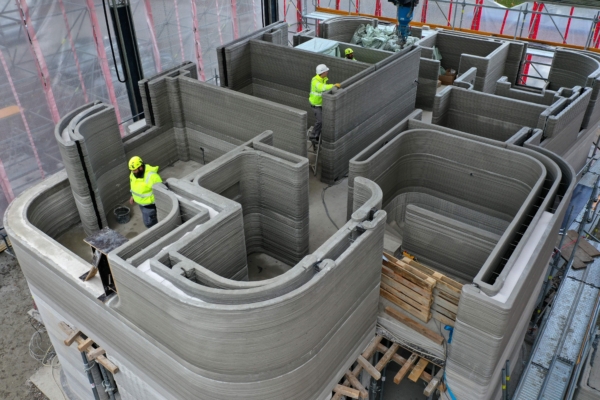An increasing number of industries are optimistic about 3D printing, with even the construction industry beginning to experiment with printing houses using materials such as cement. However, in order to do so, the industry must overcome the weaknesses of cement materials, such as lack of strength and susceptibility to collapse. In this regard, a new material has been developed by researchers at the University of Virginia in the United States to address these shortcomings and make printed houses more structurally sound.
As a new architectural technology, 3D Concrete Printing (3DCP) offers new possibilities for rapid prototyping and customization. The process involves first creating a design using Computer-Aided Design (CAD) software and then converting it into a set of instructions (G-code) for the printer, which then deposits concrete layer by layer. This technology allows for precise and rapid printing of complex shapes, reducing labor and material waste.
However, the current selection of materials available for printing is very limited, and issues of sustainability and durability still exist. As a result, some scientists have turned to abundant renewable organic polymer materials found on Earth, such as derivatives of cellulose.
The research team from the Civil Engineering Department at the University of Virginia has extracted cellulose nanofibers (CNF) from plants as a composite material, mixing it in appropriate proportions with cement for potential use in 3D printing for construction. The results of this study were recently published in the journal “Cement and Concrete Composite Materials”.
The CNF material they selected is mainly derived from wood pulp, with fibers that are long, fine, uniformly dispersed, have a high surface area, and are easily biodegradable. When mixed with cement, it can enhance the physical and chemical properties of the cement, making it suitable for improving the tensile, flexural, compressive strength, and durability of cement.
In the process, the research team first prepared a cement mortar by mixing Portland cement, calcium aluminosilicate (CSA), amorphous silica fume (SF), fly ash (FA), fine industrial quartz sand, shrinkage-reducing admixture (to minimize the risk of cracking due to drying shrinkage), and water-reducing admixture (to enhance the workability and strength of the mortar). They then added varying concentrations of CNF additives (0%, 0.1%, 0.2%, 0.3%, 0.4%, 0.5%) to create CNF concrete.
The researchers conducted tests on different proportions of CNF concrete using a rheometer to evaluate its deformation and flow behavior. During 3D cement printing, an appropriate speed and pressure are needed to extrude the concrete to avoid issues during or after printing.
Furthermore, they printed CNF concrete with different concentrations in different orientations and conducted a 28-day curing test. Subsequently, they carried out tests on the cured objects for tensile, flexural, and compressive strength to determine the impact of CNF on cement composite materials.
The results showed that the higher the concentration of CNF in cement, the greater its resistance to deformation; however, it also led to increased plastic viscosity and reduced flowability, requiring a stronger driving force for 3D concrete printing. Additionally, as the CNF concentration in cement increased, the moisture content and chemical bonds (hydroxyl groups) also increased, ensuring sufficient water and curing performance during the hydration process.
The researchers also found that when the concentration of CNF in concrete was between 0% and 0.1%, the printed layers could not maintain their shape; at 0.2%, shaping was possible but layering was not stable (easily collapsed); however, when the CNF concentration was 0.3% or higher, the shape retention rate was 99%, with less deformation in layering and good plasticity.
They conducted mechanical tests on concrete with CNF concentrations of 0.3% and above. The results showed that as the CNF concentration increased from 0.3% to 0.4%, both tensile and flexural strengths increased, but at 0.5%, a decrease was observed. Nevertheless, at a concentration of 0.3%, it exhibited the best compressive strength compared to the other concentrations.
To understand the internal factors of concrete, the researchers observed the situation of CNF at different concentrations within the cement through scanning electron microscopy (SEM). They concluded that when the CNF concentration reached 0.5%, the performance of the concrete decreased due to the aggregation of nanofibers internally, an increase in porosity, and a reduction in workability of the mortar.
In conclusion, adding CNF materials at a concentration of 0.3% or higher can significantly improve the overall effectiveness of concrete printing.
Professor Osman E. Ozbulut from the Civil Engineering Department at the University of Virginia expressed to the university’s newsroom, “We observed improvements in the printability and mechanical measurements of 3D cements after incorporating nanofibers into the material, indicating a promising path for more flexible architectural practices by integrating nanofiber materials into commercial printing materials.”
Professor Ozbulut further stated that the effects of CNF materials on traditional 3D printing composite materials were not clear in the past, “but through extensive experiments this time, we gained a better understanding of the effects of different additives to enhance the performance of 3D printed structures.”
In future experiments, the research team plans to further test the performance of CNF for use in other 3D printed components with the aim of increasing tensile strength, flexural strength, and compressive resistance.

